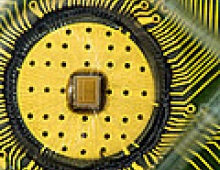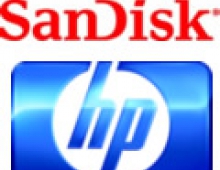
HP Researchers See Memristors As The Future Of Memory Chips
Hewlett-Packard scientists reported advances in the design of a new class of diminutive switches capable of replacing transistors as computer chips shrink closer to the atomic scale.
The devices, known as memristors, or memory resistors, were conceived in 1971 by Leon O. Chua, an electrical engineer at the University of California, Berkeley, but they were not put into effect until 2008 at the H.P. lab.
According to HP, memristance is a property of an electronic component. If charge flows in one direction through a circuit, the resistance of that component of the circuit will increase, and if charge flows in the opposite direction in the circuit, the resistance will decrease. If the flow of charge is stopped by turning off the applied voltage, the component will 'remember' the last resistance that it had, and when the flow of charge starts again the resistance of the circuit will be what it was when it was last active.
An ideal memristor is a passive two-terminal electronic device that is built to express only the property of memristance (just as a resistor expresses resistance and an inductor expresses inductance). However, in practice it may be difficult to build a 'pure memristor,' since a real device may also have a small amount of some other property, such as capacitance (just as any real inductor also has resistance).
Dr. Williams, director of the Information and Quantum Systems Lab at HP, was recognized for his breakthrough work that proved the existence of the "memristor."
The memristor could make it possible to develop far more energy-efficient computing systems with memories that retain information even after the power is off, so there's no wait for the system to boot up after turning the computer on.
Dr. Williams sees two types of applications for memristors and memristive devices.
The first, as the name "memory resistor" implies, is for a type of non-volatile random access memory, or NVRAM. Such a memory would have very useful properties, in that it would not 'forget' the data that it stores when the power is turned off. HP's researchers believe that think NVRAM made with the types of memristor materials that are currently being studied by many groups around the world could be a strong competitor to the flash memory market in about five years. The great thing is that the various metal oxides that have been identified as having a memory function are highly compatible with present chip fabrication facilities, so they can be made in existing foundries without a lot of changes being required.
Another interesting application is as an 'artificial synapse' in a circuit designed for analog computation.
Dr. Williams said that in the two years since announcing working devices, his team had increased their switching speed to match today?s conventional silicon transistors. The researchers had tested them in the laboratory, he added, proving they could reliably make hundreds of thousands of reads and writes.
That is a significant hurdle to overcome, indicating that it is now possible to consider memristor-based chips as an alternative to today?s transistor-based flash computer memories.
The most advanced transistor technology today is based on minimum feature sizes of 30 to 40 nanometers and Dr. Williams said that H.P. now has working 3-nanometer memristors that can switch on and off in about a nanosecond.
He said the company could have a competitor to flash memory in three years that would have a capacity of 20 gigabytes a square centimeter.
The H.P. technology is based on the ability to use an electrical current to move atoms within an ultrathin film of titanium dioxide. After the location of an atom has been shifted, even by as little as a nanometer, the result can be read as a change in the resistance of the material. That change persists even after the current is switched off, making it possible to build an extremely low-power device.
The new material offers an approach that is different from a promising type of storage called "phase-change memory" (PRAM) being pursued by I.B.M., Intel and other companies.
In a phase-change memory, heat is used to shift a glassy material from an amorphous to a crystalline state and back. The switching speed of these systems is slower and requires more power, the H.P. scientists say.
According to HP, memristance is a property of an electronic component. If charge flows in one direction through a circuit, the resistance of that component of the circuit will increase, and if charge flows in the opposite direction in the circuit, the resistance will decrease. If the flow of charge is stopped by turning off the applied voltage, the component will 'remember' the last resistance that it had, and when the flow of charge starts again the resistance of the circuit will be what it was when it was last active.
An ideal memristor is a passive two-terminal electronic device that is built to express only the property of memristance (just as a resistor expresses resistance and an inductor expresses inductance). However, in practice it may be difficult to build a 'pure memristor,' since a real device may also have a small amount of some other property, such as capacitance (just as any real inductor also has resistance).
Dr. Williams, director of the Information and Quantum Systems Lab at HP, was recognized for his breakthrough work that proved the existence of the "memristor."
The memristor could make it possible to develop far more energy-efficient computing systems with memories that retain information even after the power is off, so there's no wait for the system to boot up after turning the computer on.
Dr. Williams sees two types of applications for memristors and memristive devices.
The first, as the name "memory resistor" implies, is for a type of non-volatile random access memory, or NVRAM. Such a memory would have very useful properties, in that it would not 'forget' the data that it stores when the power is turned off. HP's researchers believe that think NVRAM made with the types of memristor materials that are currently being studied by many groups around the world could be a strong competitor to the flash memory market in about five years. The great thing is that the various metal oxides that have been identified as having a memory function are highly compatible with present chip fabrication facilities, so they can be made in existing foundries without a lot of changes being required.
Another interesting application is as an 'artificial synapse' in a circuit designed for analog computation.
Dr. Williams said that in the two years since announcing working devices, his team had increased their switching speed to match today?s conventional silicon transistors. The researchers had tested them in the laboratory, he added, proving they could reliably make hundreds of thousands of reads and writes.
That is a significant hurdle to overcome, indicating that it is now possible to consider memristor-based chips as an alternative to today?s transistor-based flash computer memories.
The most advanced transistor technology today is based on minimum feature sizes of 30 to 40 nanometers and Dr. Williams said that H.P. now has working 3-nanometer memristors that can switch on and off in about a nanosecond.
He said the company could have a competitor to flash memory in three years that would have a capacity of 20 gigabytes a square centimeter.
The H.P. technology is based on the ability to use an electrical current to move atoms within an ultrathin film of titanium dioxide. After the location of an atom has been shifted, even by as little as a nanometer, the result can be read as a change in the resistance of the material. That change persists even after the current is switched off, making it possible to build an extremely low-power device.
The new material offers an approach that is different from a promising type of storage called "phase-change memory" (PRAM) being pursued by I.B.M., Intel and other companies.
In a phase-change memory, heat is used to shift a glassy material from an amorphous to a crystalline state and back. The switching speed of these systems is slower and requires more power, the H.P. scientists say.





















